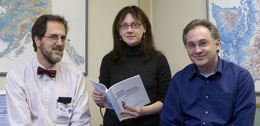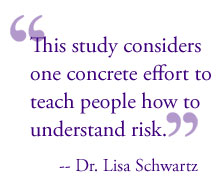
For Release: February 19, 2007 5 p.m. ET
Contact: Susan Knapp 603-646-3661
Simple Education Booklet Helps People Understand Health Risk Information
HANOVER, NH—A primer developed by Dartmouth Medical School/VA physicians helped people better understand information about health risks and interventions meant to reduce those risks. In a study published in the Feb. 20 issue of the Annals of Internal Medicine, the researchers report results of testing the primer, which they wrote.

From left, Drs. H. Gilbert Welch, Lisa Schwartz
and Steven Woloshin
"We wrote the primer because, while people are bombarded with messages about health risks and treatment benefits, little is done to prepare them to understand these messages," says Dr. Steven Woloshin, a study author and an associate professor of medicine and community and family medicine at Dartmouth Medical School.
Woloshin and his co-authors Drs. Lisa Schwartz and H. Gilbert Welch, all affiliated with Dartmouth's Center for Evaluative Clinical Sciences and the Veterans Affairs Outcomes Group at the White River Junction (Vermont) VA Medical Center, tested more than 500 people with varying levels of education. They found that their primer improved medical interpretation skills, regardless of educational background.
"This is one of the first studies we know of to go beyond simply exploring the fact that there are problems with how well people understand numbers and quantitative messages," says Schwartz. "This study considers one concrete effort to teach people how to understand risk."
The authors tested two parallel, randomized groups of people: one involving about 200 patients with low socioeconomic status (50 percent had a high school degree or less formal education) and the other with about 300 patients with high socioeconomic status (80 percent had at least a college degree). In both groups, participants were given either the primer "Know Your Chances: Understanding Health Statistics," which was developed specifically to teach people the skills needed to understand risk, or a general health booklet developed by the U.S. Department of Health and Human Services Agency for Health Care Research and Quality.

After reading the materials, participants were asked to answer questions testing their ability to interpret medical data. In the low socioeconomic group, 44 percent of those using the primer passed the test, compared to 26 percent of those receiving the general health booklet. The corresponding numbers in the high socioeconomic study were 74 percent versus 56 percent.
The researchers point out that, while good data interpretation skills are needed to make good decisions, they did not directly test the effect of the primer on actual decision making.
"We don't know of any other generic educational interventions like this," says Woloshin. "It's simple, low tech, inexpensive, and we're happy to learn that it's also effective."
This study was supported by funds from the Robert Wood Johnson Foundation, the Department of Veterans Affairs, and the National Cancer Institute.
-DMS-